The Out-Patient Angiocenters: Enhancing Safety, Efficiency, and Convenience
In the late 1980’s, I can recall attending special occasion dinners with my family. Whether these dinners were at a restaurant or at home there was an enforced dress code. The men were to wear a sport coat, dress shirt, and a tie. Additionally, with the dress code requirement, were the muttered complaints about the inconvenience of having to go home to change and why a restaurant would require such an archaic rule in order to dine.
In 1991, I went to University of Michigan and then to Chicago Medical School. While in college and medical school I was essentially in a “bubble” unaware of the changes taking place around me in society. Yes, I was able to watch the news and see reports of changes in Eastern Europe, the invasion of Kuwait, and the stock market boom due to the introduction of the internet; however, I was not aware of how society was forcing change on the old paradigms that were introduced by the earlier pre-baby boomer generations.
My first introduction to one of these changes was when I planned a dinner in a New York City restaurant. As I was taught, I dressed in shirt, sport-coat, and tie. Upon arriving at the restaurant, I found that the men were in jeans, shoes, and either a polo shirt or a button down sport shirt. This new form of smart-casual dress allowed at restaurants was now commonplace. The “dot-com” era introduced and welcomed a new lifestyle, one of increasing convenience. Although this was a subtle change, this was the first lesson I received on our changing society.
As a board certified, fully trained vascular surgeon at The Vascular Experts, I am observing ongoing change in our society and the trend towards convenience without compromising the highest of quality. In the field of vascular medicine it is the advent of the outpatient angiographic centers (angiocenters) that is introducing significant change to our patients and physicians.
Traditionally, when patients required a minimally invasive percutaneous endovascular intervention, they were brought to the hospital. The percutaneous procedures were performed in the coronary catheterization room, the interventional radiology room, or the operating room. Procedures that were commonly done in the hospital included fistulagrams for hemodialysis access and angiograms for blocked or narrowed arteries to the legs. Often patients would spend a night in the hospital but even if they were performed as an outpatient, the patients still spent an entire day in the hospital. By the time the patient goes through the admitting process, insurance verification, check-in and preoperative preparations by the nurse, speaks with the anesthesiologist, undergoes the procedure, post-operative care, and then finally check-out the patient has spent an average of eight to ten hours in the hospital.
The first sign of change for the vascular patient population was the advent of the outpatient hemodialysis access centers. Hemodialysis patients already commit 3-4 hours per day and 3 days per week to attend their hemodialysis sessions. An additional day in the hospital means that four days of the week are dedicated to a medical facility. The outpatient angiocenters have greatly improved their quality of life. Now a hemodialysis patient can come to the outpatient angiocenters at The Vascular Experts and have their fistula maintained within 30-60 minutes by a board certified vascular surgeon. This is a dramatic improvement in quality of life without sacrificing patient safety.
In the last few years, outpatient angiocenters have made their presence in today’s vascular medical world. As vascular surgeons, we have added minimally invasive arterial and venous procedures to our fistulagram armamentarium in the outpatient setting. The outpatient angiocenters have proven revolutionary in enhancing patient convenience without compromising patient safety, just as we did with the fistulagrams. The angiocenters avoid the long delays and wait times that exist in the hospital based setting. In addition, at The Vascular Experts, the patients will be welcomed by our angiocenter nurse who will expeditiously check-in the patient and then prepare the patient for the procedure by attaining IV access and prepping the operative site. Then the patient will see their board certified vascular surgeon who will be doing all aspects of the case. This is in sharp contrast to large hospitals and academic centers where ancillary physician extenders, such as residents and physician assistants, are doing parts of the procedure. After the procedure is over our staff will recover the patient in a semi-private room where food and beverage is offered. The nurse will then have the patient walk, review the medications as well as expected recovery period, and then allow the patient to go home. The one-on-one attention by the nurse offers both an enhanced safety feature and an exceptional form of service to the patient recovering from the procedure.
With improving technology and the demand for comprehensive, excellent, non-disrupting vascular care, the outpatient angiocenters have proven to be very effective at achieving the patients’ goals and exceeding their expectations. The changing landscape of medicine does have many advantages, as did the changes in other aspects of our lives.
Please contact Dr. Bauer at SBauer@TheVascularExperts.com with any additional questions.
Stephen M. Bauer, MD, FACS
Stephen M. Bauer, MD, FACS, is a board certified general and vascular surgeon at The Vascular Experts, where he specializes in all arterial and venous therapy with an emphasis on minimally invasive endovascular techniques. Read more»
Dr. Bauer practices at the Darien and Greenwich offices of The Vascular Experts.



